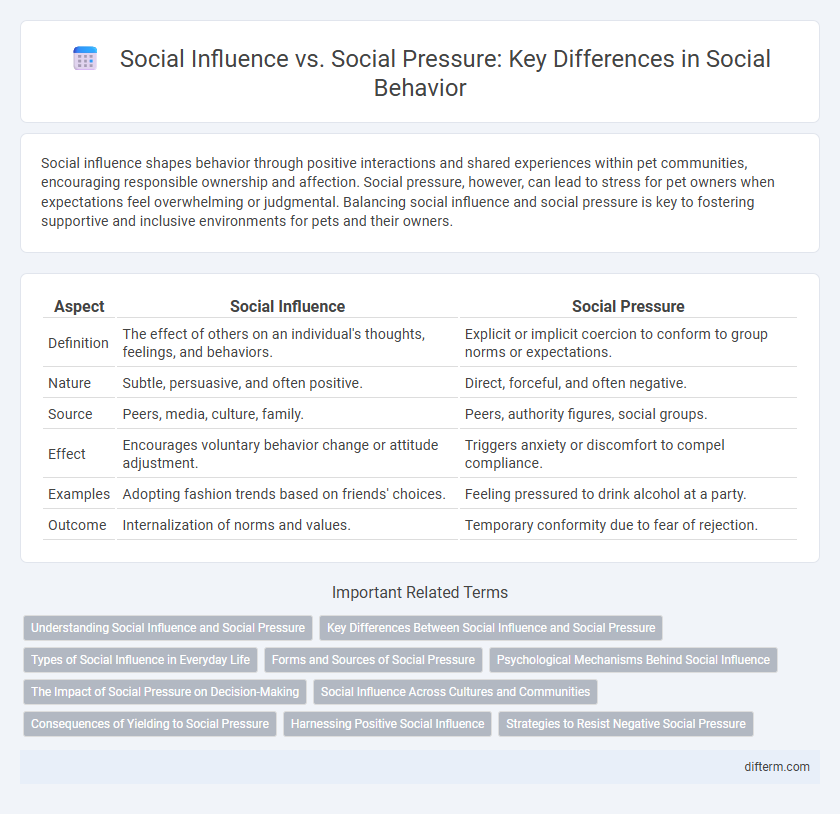Social influence shapes behavior through positive interactions and shared experiences within pet communities, encouraging responsible ownership and affection. Social pressure, however, can lead to stress for pet owners when expectations feel overwhelming or judgmental. Balancing social influence and social pressure is key to fostering supportive and inclusive environments for pets and their owners.
Table of Comparison
| Aspect | Social Influence | Social Pressure |
|---|---|---|
| Definition | The effect of others on an individual's thoughts, feelings, and behaviors. | Explicit or implicit coercion to conform to group norms or expectations. |
| Nature | Subtle, persuasive, and often positive. | Direct, forceful, and often negative. |
| Source | Peers, media, culture, family. | Peers, authority figures, social groups. |
| Effect | Encourages voluntary behavior change or attitude adjustment. | Triggers anxiety or discomfort to compel compliance. |
| Examples | Adopting fashion trends based on friends' choices. | Feeling pressured to drink alcohol at a party. |
| Outcome | Internalization of norms and values. | Temporary conformity due to fear of rejection. |
Understanding Social Influence and Social Pressure
Social influence refers to the ways individuals change their behavior to meet the demands of a social environment, often driven by internal motivations and a desire for social acceptance. Social pressure involves explicit or implicit force exerted by a group to align an individual's behavior with group norms, frequently causing conformity through fear or obligation. Understanding the distinction between social influence and social pressure is crucial for recognizing how group dynamics impact decision-making and personal autonomy.
Key Differences Between Social Influence and Social Pressure
Social influence involves voluntary changes in behavior or attitudes shaped by others' actions or opinions, fostering conformity through persuasion and modeling. Social pressure, however, exerts explicit or implicit demands, often causing stress or anxiety, as individuals feel compelled to comply to avoid rejection or punishment. Key differences include the degree of coercion, with social influence being more subtle and internalized, while social pressure is direct and externally enforced.
Types of Social Influence in Everyday Life
Social influence manifests in various forms such as conformity, compliance, and obedience, shaping individuals' behavior in everyday life. Conformity involves adjusting actions or beliefs to match group norms, while compliance refers to yielding to direct requests from others. Obedience entails following explicit commands from authority figures, highlighting the complex ways social forces guide decision-making and social interactions.
Forms and Sources of Social Pressure
Social pressure manifests through explicit demands like peer expectations and implicit cues such as cultural norms, shaping individual behavior within a group. Sources include authoritative figures, family, friends, and mass media, each exerting varying degrees of influence depending on context and relationships. These forms of pressure often operate simultaneously, reinforcing conformity and social cohesion through mechanisms like approval, punishment, and stereotype endorsement.
Psychological Mechanisms Behind Social Influence
Social influence operates through psychological mechanisms such as conformity, compliance, and internalization, driving individuals to align their behaviors and attitudes with group norms. These mechanisms leverage cognitive processes like social validation and the desire for acceptance, distinguishing social influence from social pressure, which often involves overt coercion or forceful demands. Understanding these underlying psychological drivers reveals how subtle shifts in perception and motivation shape social behavior in diverse contexts.
The Impact of Social Pressure on Decision-Making
Social pressure significantly impacts decision-making by compelling individuals to conform to group norms, often overriding personal preferences and critical thinking. This influence can lead to conformity even when choices conflict with one's values or best interests, highlighting the power of peer pressure and social expectations. Understanding the mechanisms of social pressure reveals its role in shaping behavior within social environments and decision outcomes.
Social Influence Across Cultures and Communities
Social influence varies significantly across cultures and communities, shaping behaviors through norms, values, and expectations unique to each group. In collectivist societies, social influence often aligns with group harmony and consensus, while individualistic cultures emphasize personal autonomy and self-expression. Understanding these cultural nuances is essential for effectively navigating social dynamics and fostering inclusive environments.
Consequences of Yielding to Social Pressure
Yielding to social pressure often results in compromised personal values and diminished autonomy, leading individuals to conform to group norms even when they conflict with their beliefs. This conformity can cause increased stress, anxiety, and a loss of self-identity over time. In extreme cases, persistent social pressure may contribute to mental health challenges and hinder critical thinking and independent decision-making.
Harnessing Positive Social Influence
Harnessing positive social influence involves leveraging group norms and shared values to encourage behaviors that benefit individuals and communities, such as promoting cooperation, healthy habits, or environmental responsibility. Unlike social pressure, which often relies on coercion or fear of exclusion, positive social influence fosters intrinsic motivation through empathy and mutual respect. Effective strategies include role modeling, positive reinforcement, and creating inclusive environments that empower individuals to make supportive choices.
Strategies to Resist Negative Social Pressure
Effective strategies to resist negative social pressure include developing strong self-awareness and assertive communication skills to maintain personal boundaries. Building a supportive network of like-minded individuals reinforces confidence and reduces vulnerability to peer influence. Practicing critical thinking and evaluating the motivation behind social demands helps in making independent, value-driven decisions.
social influence vs social pressure Infographic

 difterm.com
difterm.com